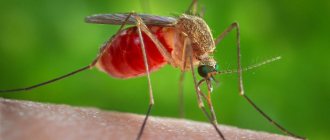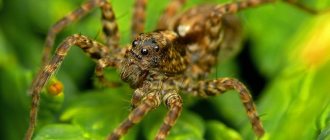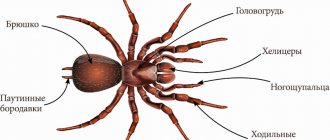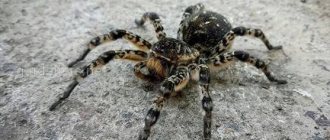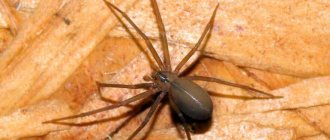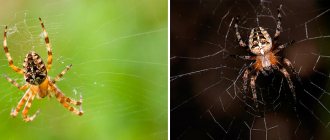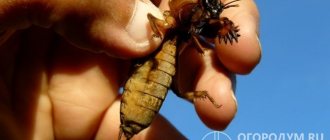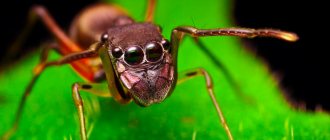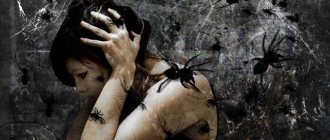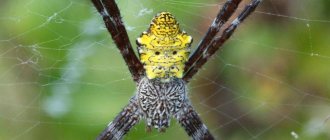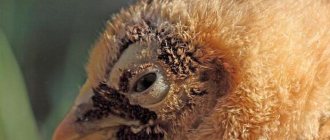Spreading
Widely distributed in Southern Europe, Western Asia and North Africa - from Portugal and Spain to Central Asia. For example, in Bulgaria, karakurt inhabits the southern parts of the country - the Strandzha, Sakar and other elevated areas; during the summer months it moves north. In Russia it is found from the European part to southern Siberia.
Female hiding in the corner of a trapping net, Moncodonja, Croatia
It lives on plains - in fields, meadows, arable lands, steppe regions and especially on grassy uncultivated lands, open dry areas. It can be found in barns, stables and even in human habitations. Found on dunes, sandy and rocky shores.
Rocky coastal landscape near the town of Calvi on the French island of Corsica, one of the habitats of the karakurt
Typically found frequently in suitable habitats. However, the prevalence fluctuates greatly and varies from year to year. In Istria (a peninsula in the Adriatic Sea, in the northern part of Croatia), for example, in some years the species was almost not found, in others, on the contrary, the number of spiders there was quite high.
Due to its high population density and prevalence, the status of the species is not of concern.
How to prevent a bite
For adults. In areas where poisonous spiders live, try to wear closed shoes and long trousers. Pay attention to the webs located closer to the ground. Do not camp or picnic in such areas. Just be careful. Remember that in Crimea, karakurts are found even on the beaches, in the coastal grass.
For children. Tell your child about karakurts. If you are walking in an area where it may live and you see webs on the ground, change your walking location to a safer one.
So he weaves a web among the stones
Summarize. Karakurts are dangerous, but not aggressive and attack, mostly due to our carelessness when we get too close to them. Observing the precautions described above will allow you to have a trouble-free vacation while hiking in the southern coastal countries.
Video of the fight between karakurt and scorpion
Description
The body length of females is from 7 to 15 mm, males - from 4 to 7 mm. Black in color, males and young females have thirteen red spots on the opisthosoma (abdomen), giving the species the name tredecimgutattus (Latin for “thirteen spots”); sometimes these spots are absent, and the spider can be completely black, and the spots can also merge. On the ventral (ventral) side there is a red hourglass-shaped pattern typical of true widows (Latrodectus), which, however, can also be reduced in some individuals to two transverse stripes. The body is covered with velvety hairs. The hairs are forked.
As with other species of true widows, the male European black widow is significantly smaller than the female. Sexual dimorphism (difference between sexes) is also expressed in differences in shape and color.
Female
Females
The main color of the female is black. Prosoma is from 3 to 5.2 mm long, black in color, appears shiny, slightly longer than wide. The legs are black, longer and stronger than those of the male.
Opisthosoma spherical. The spots are edged with white, especially in young females. The epigyn (female genital organ) consists of two connected sperm receptacles (sperm sacs).
Female
Males
The male is much smaller than the female and has a less strong build, and has a more contrasting color. The main color is also black, but with a noticeable brownish tint. The spots on the opisthosoma of males are bordered with white, like those of young females.
Male
Appearance
To get a more visual idea of what the karakurt spider looks like externally, you should refer to the photos, of which there are a huge number on the Internet. In words, a spider can be described as follows.
Its body is smooth and, like other arthropods, consists of an abdomen and cephalothorax. It has four pairs of limbs attached to its abdomen and two pairs of jaws. The abdomen consists of segments and an anal cavity. The female also has additional jaws, the so-called chelicerae, where special glands that produce poison are located.
On the back of the spider there are reddish dots, around which white lines stretch. It was their presence that served as the basis for such an unusual name as “karakurt”. Translated from Latin, this word sounds like “thirteen points.” This species is characterized by molting. The female is several times larger than the male. For example, if the body length of a male reaches seven millimeters at most, then the size of a female varies from one to two centimeters.
Similar species
Confusion sometimes arises with similar species of black widows (Latrodectus), as well as with species from the genus Steatoda, which also belongs to the family of web spiders (Theridiidae), such as the false karakurt, or Paykull's steatoda (S. paykulliana). It is similar to the karakurt in the shape of the opisthosoma and also has noticeable markings, but usually has only one red or yellow transverse stripe on the lower part of the abdomen.
In addition, the karakurt is usually slightly larger than the false karakurt and has a different eye arrangement. In addition, in all steatodes, including false karakurt, unlike black widows, the chelicerae are serrated.
The false karakurt is also found in the Mediterranean and prefers habitats similar to those of the karakurt.
Female false karakurt (Steatoda paykulliana)
How to visually distinguish it from ordinary spiders
Karakurts are small in size. Their body is spherical, slightly teardrop-shaped. The female is 3-4 times larger than the male. Its size varies from 1 to 2 centimeters. The male is only 5 millimeters long. The color of the spiders is radically black, but juveniles may have red or dark orange spots, sometimes with a white or yellow outline. In adult individuals such spots may be absent. European species of black widows, found along the Mediterranean coast, have a characteristic body sheen. The hairline is completely absent.
What does he look like in the photo
Another distinctive feature of karakurts is their long front legs.
Lifestyle
It stays close to the ground and, like many web spiders, constructs a trapping network typical of the family for the purpose of catching prey, consisting of several trapping threads stretching to the ground. At the top there is a key-shaped shelter that serves as a night shelter. The net is usually placed near the ground, in the grass or under overhanging rocks.
Female in a trapping net, Rabac (Istrian peninsula), Croatia
Spectrum of production
Karakurt has a wide range of prey, as the nature of trap net construction means that food is taken passively. The range of prey also depends on the age stage of the spider. Typically, food consists of various arthropods, especially large insects.
Female with a captured male longhorned beetle Psilotarsus brachypterus
Thanks to its effective fishing technique, the karakurt can catch very large or difficult prey, such as large locusts. Other spiders also serve as prey, including males of other species that wander at night in search of females, ending up in the hunting nets of karakurts. There are also reports of small vertebrates, mainly lizards, being caught.
Female, on the right are the remains of prey - another spider
Life cycle
The life cycle of karakurt is divided into several phases and also depends on the season.
Phenology
The active period of adult females is from May to November. In adult males this period is shorter and they are found from May to September.
Reproduction
A sexually mature male looks for a female that has not yet matured and penetrates her network, which he usually never leaves. Once the female moults for the last time and becomes an adult, he ties her up in a web and mates with her. The female quickly frees herself from the threads and usually devours the male, hence the name “black widow”, coupled with its appearance.
Some time after mating, the female weaves up to five cocoons, 14–17 mm long and 12–15 mm wide, tapering on one side. The cocoons are initially white or cream-colored, then turn yellowish before darkening again shortly before hatching, which in laboratory conditions occurs at 27 °C 49 days after the cocoon is created. However, it is believed that incubation (the maturation of the young in the eggs and the time until hatching) in the wild can take significantly longer, and the young also overwinter.
The cocoon contains about 103 eggs, with the hatching rate of females (57%) being slightly higher than that of males (about 43%). Eggs are toxic, although the composition of egg proteins is more complex than the composition of toxins. This feature is also characteristic of other types of black widows.
Female weaving a cocoon
The hatched and already poisonous young spiders initially stay with their mother. Before becoming adults, they go through several instars (stages), males molt 4–5 times, and females 8.
average life expectancy
The male grows for approximately 108 days and can reach a total lifespan of 180 days. The female takes 215 days to grow and lives longer than the male - approximately 302 days.
What does karakurt look like?
Karakurt looks like a medium-sized spider. Karakurt females are significantly larger than males in size. The female karakurt grows 2 cm in size, while the male karakurt is only 0.7 cm in size.
Karakurt looks quite unusual. The karakurt spider has a black body, and on its abdomen it has red or orange spots of various shapes. Both male and female karakurt have this coloration. Sometimes there may be a white outline around the spots. Often, upon reaching maturity, the karakurt spider can acquire a completely black color without spots.
Human interaction
Karakurt, like many other true widows (Latrodectus), including “black widows” and similar steatodes belonging to the same family, often inspire fear with the consequences of their bite. On the other hand, thanks to the effective technique of catching prey, the species is considered as one of the possible ones for use in the framework of biological pest control in agriculture. Moreover, due to its properties, not least the high toxicity of various poisons, the spider has become an object of scientific research of high importance; it is also sometimes kept in terrariums as a pet.
Karakurt on a 2008 Azerbaijan postage stamp
Bite
Females are dangerous, and it is characteristic of this spider that it attacks if disturbed, usually trying to escape, and biting only as a last resort. Active mainly at night.
Most often, agricultural workers become victims of bites during harvesting, since the spider prefers the countryside. Accordingly, in urban areas, which the species avoids, bites are rare, unlike, for example, the closely related black widow (Latrodectus mactans). Fortunately, in Europe, bites from this spider have become quite rare in recent decades.
Karakurt bite
The poison of the karakurt is quite strong, so a bite from a karakurt can be fatal. Fortunately, the karakurt attacks only if it is disturbed. Karakurt poison affects both animals and humans. The karakurt bite is not immediately noticeable and manifests itself within 10-15 minutes. During this time, the karakurt poison is already spreading throughout the body and the first signs of toxic poisoning begin to appear. Symptoms of a karakurt bite begin with a burning pain that spreads throughout the body. Typically, patients complain of severe pain in the chest, abdomen and lower back.
Also, a karakurt bite has the following symptoms: increased heart rate, shortness of breath, palpitations, dizziness, headache, trembling, vomiting, sweating, spasms in the bronchi and urinary retention. In the later stages of poisoning, a person begins to experience blackouts and delirium. Cases of death have been recorded in people and farm animals that were bitten by karakurt.
Experts say that people with strong immunity can more easily withstand a karakurt bite than those weakened by illness or those with allergies. It should be remembered that the highest concentration of venom in black widows occurs during the mating season and after laying eggs; in other seasons, bites are less terrible. Males, in principle, do not pose a danger, since they do not possess poison and, due to their small size, cannot bite through the skin.
To neutralize the effects of karakurt poison, anti-karakurt serum is used. Novocaine, calcium chloride and magnesium hydrogen sulfate are also administered intravenously, which give positive results. If it is impossible to get medical help, you should cauterize the karakurt bite with a burning match. But this must be done no later than 5 minutes after the bite. You can also cauterize the bite site with a hot metal object. Since the spider bites through the skin to a depth of only 0.5 mm, the heat destroys the venom that has not had time to be absorbed. But even after cauterization, you must seek medical help.
Livestock suffers from karakurt bites, especially camels and horses. These animals often die from karakurt poison. Once every 10 years, a mass reproduction of the karakurt spider occurs; during these years, livestock farming suffers large losses. Now karakurt is destroyed with the help of insecticides that are sprayed on the soil. Of course, the poison of the karakurt is not aimed at causing harm to humans or livestock, but serves the spider only to obtain food. Karakurt eats various beetles, flies, locusts, cicadas and grasshoppers.
Toxicity
The toxicity (venom effect) of a spider bite to humans is controversial. While the original writer Pietro Rossi, one of the leading entomologists of the 18th century, mentioned that the spider's venom could kill a person, the poisonous effect was almost completely refuted in early 20th century France. Sometimes the effect of a bite is described as the effect of a wasp sting. Fatalities occur only in very exceptional cases, in approximately 4–5 out of 1000 bites, corresponding to 0.4%. Other sources say that about 5% or 0.2% of untreated bites are fatal.
What poisonous spiders can you find?
There are many poisonous spiders living in the Krasnodar Territory. Some representatives with their bite can lead to instant death.
There are many types of poisonous spiders
Karakurt
Karakurt prefers arid areas. Lives in burrows underground. Does not behave aggressively towards people. In most cases, a karakurt attack occurs by accident when a person does not notice the insect in shoes or on things. In this case, the spider bites for protection.
After a bite, the skin swells. There is severe pain and redness. Within 10 minutes your overall health deteriorates. The following symptoms appear:
- nausea and vomiting;
- painful sensation in the head and stomach;
- muscle spasms;
- difficulty breathing;
- increased blood pressure;
- fainting state;
- rapid pulse;
- weakness;
- lack of appetite;
- rashes on the skin.
If first aid is not provided in a timely manner, cardiac arrest occurs.
The female reaches 2 cm. Males are smaller. Young spiders are more active. Gradually the color becomes more uniform. Young insects have dark spots on their bodies.
Karakurt is very dangerous
Spider toxin
Karakurt poison, which has been studied many times due to its effect, consists of 146 toxin-like proteins, which, depending on their function and bioactivity, are divided into five groups:
- neurotoxins (nerve toxins),
- auxiliary toxins,
- peptidases (enzymes that can break down proteins or peptides),
- protease inhibitors (molecules that inhibit peptidases)
- other toxins whose function is unknown.
The majority of the toxins are neurotoxins, which, as in all true widows (Latrodectus), include alpha-latrotoxins (α-LTX), of which the species has 21. They range in size from five to six picometres and have a molecular weight of 110 to 140 kilodaltons and upon binding to certain neuronal receptors causes a massive release of neurotransmitters from nerve endings in a group of animals that must be exposed to the corresponding neurotoxins (nerve poisons). The seven alpha-latrotoxins are latroinsectotoxins (LITs), which are neurotoxic to insects. Nineteen other alpha-latrodinines have effects in vertebrates. In addition, it contains a component called α-Latrocrustatoxin (α-LCT), which causes neurotoxic effects in crustaceans. Other neurotoxins are four ankyrins (pentapeptide repeat proteins) and eight lycotoxins.
Accessory toxins likely include 62 teriditoxins, which appear to serve to enhance the effects of the neurotoxins.
Spider toxin peptidases are formed from 16 trypsins, which help in the maturation of toxins and digestion of food.
Protease inhibitors include nine ctenitoxins, which protect neurotoxins and accessory toxins from proteolytic breakdown of prey, as well as orphan toxins, which block proteases or peptidase inhibitors and prey ion channels. The latter function is also performed by three so-called SCP peptides.
There are also four other toxins whose function is unknown and which are similar in properties to scorpion toxins.
Research has shown that the karakurt spider toxin is similar to the western black widow (Latrodectus hesperus) toxin, especially with respect to the structure of the toxins, hydrolases and inhibitors. However, the venom of the western black widow contains fourteen ankyrins (repetitive proteins), while the venom of the karakurt contains thirteen.
Western black widow (Latrodectus hesperus)
Egg toxicity
Karakurt eggs are also toxic to other organisms, but the eggs studied did not contain the same typical proteins found in true widow spider toxins. This means that eggs have their own toxic mechanism. Eggs are known to have four different and completely unique toxins, designated latroeggtoxin-I through -IV.
- Latroeggtoxin-I has a molecular weight of 23.8 kilodaltons. In experiments with mice, it was found that it reversely blocks their neuromuscular synapses.
- Latroeggtoxin-II has a molecular weight of 28.7 kilodaltons. Electrophysiological studies in rats have shown that the toxin selectively inhibits sodium channels in the spinal ganglia (nerve ganglia in the spinal canal) that are resistant to the nerve poison tetrodotoxin, without significantly affecting sodium channels that are resistant to tetrodotoxin.
- Latroeggtoxin-III has a molecular weight of about 36.0 kilodaltons and was experimentally neurotoxic to cockroaches, but not to mice, which probably indicates that, unlike the previous two latroeggtoxins, it has an effect only on insects. Further studies using the BLAST algorithm revealed that latroeggtoxin-III is a proteolytic (protein-degrading) toxin and contains vitellogenins.
- Latroeggtoxin-IV differs significantly from other latroeggtoxins in that, unlike them, it acts as an antibiotic. It has a molecular weight of 3.6 kilodaltons and has been shown to be particularly effective against Staphylococcus aureus and S. typhimurium, as well as Bacillus subtilis, Escherichia coli and Pseudomonas aeruginosa.
Pseudomonas aeruginosa
Offspring toxicity
Like eggs, young karakurts also have toxic properties. Internal studies of newly hatched spiders showed that they contained 69.42% proteins, which varied in molecular weight and isoelectric points. Peritoneal injections of the internal extract in mice at a rate of 5.30 milligrams per kilogram of body weight of the corresponding mouse and in cockroaches at an amount of 16.74 micrograms per gram of body weight of the corresponding cockroach showed obvious symptoms of poisoning and also resulted in death in some individuals.
Electrophysiological studies on mice injected with the extract at a concentration of 10 micrograms per milliliter showed that their nerves in the diaphragm could be completely blocked within 1.5 to 21 minutes. When administered at a concentration of 100 micrograms per milliliter, this can also be achieved by supplying voltage-activating sodium, as well as by supplying calcium to the dorsal ganglion ion channels.
Possible causes of toxicity of eggs and offspring
It is still not fully understood why both eggs and young animals in the early stages also have poisonous properties. One theory is that this toxicity provides protection from other predatory arthropods. It has been shown that toxins from karakurt eggs have a negative effect on the common spider (Araneus diadematus). Some specimens given 3-5% of their body weight toxins in a laboratory experiment showed abnormal network-building activity, and those given 1% of their body weight toxins died six hours after administration.
Another possibility is that the toxic properties of these stages also serve as antibacterial protection. The female karakurt usually lays cocoons in the trapping net, where it can sometimes be dark and damp, thus these places provide good opportunities for the development of microorganisms, to the pathogenic effects of which eggs and young are sensitive. Spiders can also come into contact with these microorganisms by consuming food.
Species of spider
Entomologists have not yet decided on the variety of karakurt species, however, according to current statistics, there are about 22 of them, among which Latrodectus tredecimguttatus (European black widow) and Latrodectus pallidus (white karakurt) are separately distinguished.
Four indentations on the abdomen in the shape of a rectangle, a light yellow color, and a brown head are striking signs of the white karakurt, which lives in North America and Africa. The remaining insect species officially recognized in entomology are considered poorly studied.
Symptoms
A karakurt bite can be accompanied by various physiological complications. The bite itself feels like an injection, after 1–2 minutes the bite site turns red and a bluish-red spot appears, surrounded by a pale halo. 10–15 minutes after the bite, general malaise, weakness, dizziness, numbness, sweating begin, and in more severe cases, tremors of the limbs, muscle pain, dull pain in the chest, fever, and even convulsions. The pain usually lasts 1 to 2 days, and other symptoms last from 1 to 4 days, depending on the case. The poison is dangerous not only for humans, but also for many domestic animals. Except in sheep, which are immune, the poison typically causes serious illness, even death, in horses and cattle. For a bite, a special serum is used, the wound is washed with a solution of potassium permanganate (potassium permanganate), etc.
Frequency of occurrence of symptoms in percentage:
- increased sweating - in 70% of cases,
- nausea and vomiting - less than 20%,
- fever and neuromuscular effects - 10%,
- hypertension - less than 10% of cases.
Often the connection between symptoms and a spider bite may not be established, since most symptoms of this clinical picture, called latrodectism, become noticeable only after 20 minutes to 2 hours. Misdiagnosis and mistreatment are often the result, as spider bites are relatively rare in Europe and hospitals lack both experience with these poisoning symptoms and antitoxin. For example, in the Almeria hospital in Spain, located in a known spider distribution area, there were only twelve hospitalizations of bite victims between 1984 and 1994. Almost all of them were agricultural workers who mainly worked in greenhouses. In the open ground there was almost no contact with the spider.
My beast: how the poisonous spider Karakurt settled in Kuban
“Notebook Krasnodar” continues to talk about animals that live in the Krasnodar region. Next up is the Karakurt spider, which belongs to the black widow family.
This spider, despite its small size, is very dangerous. Its bite can lead to death.
How to identify this little messenger of death? Karakurt females reach sizes up to 2 cm, and males and small individuals up to 1 cm. They have characteristic red spots with a white edge on their body. There are 13 of them. However, adult individuals may not have such spots. But this type of spider has no hair at all. Only females pose a danger to people, since males are simply not able to bite through human skin.
Where do they mainly live? Karakurts mainly love steppes and deserts. However, as a result of global warming, these spiders began to settle en masse in Russia, in particular in the Krasnodar Territory. It’s true that spiders live only in dry places where people usually don’t go. Black widows prefer to settle in the burrows of voles, dry piles of old garbage, in stone rubble and cracks.
“It used to be that karakurt did not wander into the Kuban, but with the onset of global warming it is no longer possible to talk about this,” says Andrey Chushkin, biologist, senior researcher at the field research laboratory of the Krasnodar State Historical and Archaeological Museum-Reserve named after Felitsyn. - Moreover, Kalmykia is not far away, where such spiders are a common sight. Now it is also found in Crimea. And individual individuals were found even in the Moscow region.
As we have already noted, only Karakurt females are dangerous. You should be especially careful in June-July, when they have mating season. Most often, it is at this time that bites occur.
The male attracts the female with fragrant pheromones. But the life of a male is short. Immediately after mating, the spider eats its partner. Raising the offspring falls entirely on the shoulders of the “mother”. On average, the number of eggs reaches 130 pieces. With the arrival of autumn, the female dies.
Offspring are born in April. However, the cubs do not immediately leave their shelter. First, they eat all the supplies that their mother left for them, and then they begin to eat their brothers. The “law of the jungle” already applies here - survival of the fittest. A year later, the spiders emerge from the cocoon next spring and become sexually mature in June–July.
What do Karakurts eat? The black karakurt feeds on insects that fall into its nets. These are usually those types of arthropods that live directly next to the spiders themselves: beetles, grasshoppers, locusts, flies and horseflies. It is interesting that the victims of karakurts are caught in horizontally stretched nets. At the same time, the web of karakurts is not distinguished by the grace of circular lines, but is made as if randomly, but at the same time it is very viscous and does not give the insect caught in it any chance of salvation. The spider paralyzes the caught insect with poison and then sucks out its liquid tissue.
How can you recognize that you have been bitten by a karakurt? At first you won't feel anything. You may feel severe pain within 10-15 minutes or within an hour. All the muscles of the body begin to ache, as happens with the flu or other colds. The muscles that hurt the most are the chest, abdominals, and lumbar region. In addition, the heart rate increases, shortness of breath appears, dizziness, and tremors of the limbs. After this, general weakness of the body sets in, it seems that the limbs do not obey the person, and vomiting appears. Next, nervous exhaustion occurs in the human body and depression may occur. A person’s consciousness becomes cloudy, and he ceases to be aware of reality and even recognize people close to him.
The most effective way after a bite is to immediately cauterize the wound. This allows you to destroy the poison, preventing it from spreading through the blood throughout the body. The fact is that the female bites through the skin only half a millimeter, and for some time the poison concentrates almost on the surface. And, of course, you need to seek help from specialists.
Previously, Notebook Krasnodar wrote about the bison, raccoon, otter and other animals inhabiting the Krasnodar region.
Kostya Cherny
News on Notepad-Krasnodar
Tarantism
Today, a karakurt bite is also considered as the cause of tarantism, a kind of “St. Vitus’ dance”, in which, in addition to convulsions and involuntary twitching, hallucinations can occur. These symptoms of poisoning were difficult for medieval people to classify, leading, starting in the city of Taranto in southern Italy, to a veritable hysteria that spread to Spain in the 15th century. Although the symptoms were soon attributed to a spider bite, they were blamed on the Apulian tarantula (Lycosa tarantula). The tarantula is much less poisonous than the karakurt, but it is much larger and active during the day, so people could observe it much more often than the nocturnal karakurt, which hides under stones during the day. Later, the name tarantula was transferred by the Spaniards to tarantula spiders living in South America.
Female Apulian tarantula (Lycosa tarantula) with spiderlings
Therapies of the time included sweating or treatment with excrement. Patients were perhaps best served by the tarantella, a piece of music originally composed for the purpose of putting bite victims out of their misery through fast dancing. This "healing method" was still recommended by the Spanish Medical Association in 1875.
Who is dangerous for karakurt?
Despite the fact that this type of spider is considered the most dangerous in the world, and its bite can kill, karakurts have their own enemies who can destroy them.
The natural enemies of karakurts are herd animals. Sheep, cows and horses can trample hectares of steppe and destroy all the spiders living there.
Spiders are the diet of some animals and insects. For example, hedgehogs are not at all afraid of karakurts, because armor made of needles reliably protects them, so they can eat a spider of this species.
The spider nymphs lay their eggs directly into cocoons made by the female black widow, and their larvae eat the spider nymphs.
Sphex wasps attack spiders, inject them with paralyzing poison, and then kill them.
In terrarium art
Karakurt, like some other spiders, is sometimes kept by terrarium keepers as a pet, which is sometimes due to the appearance of the spider. The advantage is the small space that the spider requires due to its species-specific lifestyle, which allows it to be kept in relatively small dwellings (mainly terrariums). Due to the spider's natural habitat, the temperature can and humidity should be quite low. It is imperative to provide the possibility of constructing a trapping net and shelter that the animal can use and expand. Thus, keeping a karakurt as such is relatively simple, but you should be aware of the possible dangers it poses before you decide to get yourself such a pet. A beginner, of course, is strongly recommended to pay attention to more “traditional” non-aggressive and relatively safe tarantulas, for example from the genus Brachypelma.
Tarantulas are much safer as pets (pictured: Lasiodora parahybana or Brazilian pink tarantula)
Etymology
The specific epithet tredecimguttatus means "thirteen spots". In 1778, the karakurt had already been described as Aranea brevipes, but this description was ignored by later editors and is today excluded from taxonomy as a forgotten name (nomen oblitum), hence Pietro Rossi's description in which he named the species Aranea 13-guttata in Fauna Etrusca , has become valid. Rossi already mentions the variability of the species, however, later attempts were made to identify specimens with fewer red spots on the abdomen and other features as separate species. In 1805, Charles Walkener placed the spider in the new genus Latrodectus as part of his revision of the genus Aranea. In 1966 it was placed as a subspecies of Latrodectus mactans, but promoted to species again in 1983.
In different countries, the spider is also known by other names:
- Pietro Rossi in the first description also mentions the Italian trivial name Marmignatto for this species of spider. Hence the Germanized name Malmignatte. In 1837, Charles Walkener, in his work Histoire naturelle des insectes, described the species Latrodectus malmignatus, identical to the karakurt. Most often, “Malminhatte” refers to the European black widow, but sometimes species living on other continents can also be called this.
- The name "karakurt" is used in southern Russia and Central Asia. The meaning of this word, which can be translated as “black wolf,” indicates the danger of the spider to animals and humans, which is assessed by the population of these areas as high. Every summer there are reports from Kazakhstan that a large number of camels die from bites if they are not treated with antiserum: the country does not produce the serum, and the antivenom produced in Uzbekistan costs more than $130. According to another point of view, the name translates as “black insect” (Wikipedia also adheres to this version).
- Used in many European languages, the later name "black widow" stems from the observation that the female, after mating, eats the smaller male, thereby turning herself into a "widow". However, this behavior, which can also be observed in most other spiders and some other arthropods, is not the rule.
- In Spanish, the name araña sangrienta is also used, which translates to "blood spider", probably due to the spots in the coloration.
Detail from page 695 of the German magazine Die Gartenlaube by publisher Ernst Keil (1879)
